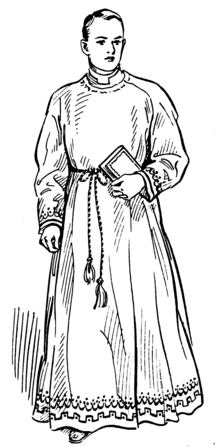Alb

The alb (from Latin (tunica) alba "the white (tunic)") is an ankle-length garment made of white or now natural-colored linen that emerged from the ancient tunic . With reference to the old church and its tradition, the alb symbolizes the baptismal robe.
Catholic and Orthodox worship
Traditionally worn by priests as a liturgical undergarment under the chasuble , the alb is currently seen as the basic garment of all those who perform a special service in worship , e.g. B. acolytes , lecturers , communion helpers .
“The liturgical garment corresponding to all consecration stages is the alb which is held in place with a belt ; unless it's made to be worn without a belt. If the alb does not close well on the neck, you should wear a shawl. The alb cannot be replaced by the choir skirt if chasuble or dalmatic are to be put on or the stole replaces the chasuble or dalmatic . For mass and other related liturgical celebrations, the priest wears the chasuble over alb and stole, unless otherwise provided. The robe of the deacon is the dalmatic, which is worn over the alb and stole. All others who serve at the altar and are not priests or deacons can wear a different garment that is lawfully approved in the individual areas. "
Since the Middle Ages, ornaments in the form of borders or embroidery have been common, especially on holiday albums and albums for the bishop. In modern times, lace was widely used as jewelry, especially when it could be industrially manufactured. The shorter choir rock developed from the alb .
While putting on the alb, the priest says the following dressing prayer: Dealba me, Domine, et munda cor meum; ut, in sanguine Agni dealbatus, gaudiis perfruar sempiternis. ("Purify me, O Lord, and purify my heart, so that, washed white in the blood of the Lamb, I may enjoy eternal joys").
In the Orthodox churches , the alb corresponds to the sticharion .
Protestant service
In the Evangelical Lutheran Church, the choir shirt , which was worn over the gown during communion services until the 20th century in some areas (e.g. in Saxony ) , was called the alb. The alb in its modern form as a cloak alb with stole (sometimes incorrectly referred to as the "white gown") has gained acceptance in almost all Protestant churches, especially through ecumenical exchange. It is also worn on special liturgical occasions by pastors , in some parishes as an official costume by lecturers and preachers .
In the Evangelical Lutheran Church in Württemberg was established in 2002 to deaconesses and deacons allowed and the Prädikantinnen and preachers, for the service of the public proclamation of the Word in worship to wear a natural white Mantelalbe without stole a liturgical garment. Since then, pastors have also been allowed to wear cloaks and stoles at normal church services if the local parish council agrees.
By wearing the alb in the Protestant regional churches, the congregation and the bearer themselves are reminded of their baptism and reference is made to Luther's teaching on the priesthood of all baptized .
In the Independent Evangelical Lutheran Church , the alb with stole can be worn by the pastor for both sermon and sacrament services according to the liturgical color of the church year .
literature
- Joseph Braun : The Liturgical Paraments in the Present and Past. Reprographic reprint of the second, improved edition, publisher nova & vetera, Bonn 2005, ISBN 3-936741-07-7 , pp. 74-81.
Individual evidence
- ↑ General introduction to the missile book , AEM, 298–301
- ↑ Joseph Braun: The Liturgical Paraments in the present and past. Reprographic reprint of the second, improved edition, publisher nova & vetera, Bonn 2005, pp. 78–80.
- ^ Ernst Hofhansl: vestments, liturgical. In: Gerhard Müller (Hrsg.): Theologische Realenzyklopädie . Volume XIII. Walter de Gruyter, Berlin - New York 1984, p. 164 ff.
- ↑ Circular on the use of the coat albums in church services / decree of the Upper Church Council of the Evangelical Church in Württemberg regarding liturgical clothing and official clothing from October 8, 2002.
